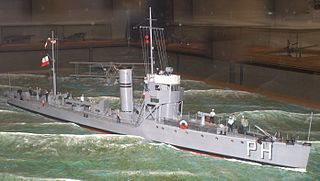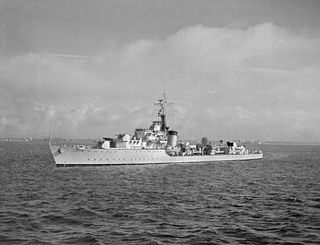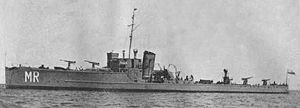
ORP Błyskawica (Lightning) is a Grom-class destroyer which served in the Polish Navy during World War II. It is the only Polish Navy ship to have been decorated with the Virtuti Militari, Poland's highest military order for gallantry, and in 2012 was given the Pro Memoria Medal. Błyskawica is preserved as a museum ship in Gdynia and is the oldest preserved destroyer in the world. Błyskawica is moored next to the Dar Pomorza.

ORP Orzeł was an Orzeł class submarine of the Polish Navy that served during WWII.

HMS Repulse was one of two Renown-class battlecruisers built for the Royal Navy during the First World War. Originally laid down as an improved version of the Revenge-class battleship, her construction was suspended on the outbreak of war because she would not be ready in time. Admiral Lord Fisher, upon becoming First Sea Lord, gained approval for her to resume construction as a battlecruiser that could be built and enter service quickly. The Director of Naval Construction (DNC), Eustace Tennyson-d'Eyncourt, quickly produced an entirely new design to meet Admiral Lord Fisher's requirements and the builders agreed to deliver the ship in 15 months. They did not quite meet that ambitious goal, but the ship was delivered a few months after the Battle of Jutland in 1916. Repulse and her sister ship Renown were the world's fastest capital ships upon completion.

HMS Iron Duke was a dreadnought battleship of the Royal Navy, the lead ship of her class, named in honour of Arthur Wellesley, 1st Duke of Wellington. She was built by Portsmouth Dockyard, and her keel laid in January 1912. Launched ten months later, she was commissioned into the Home Fleet in March 1914 as the fleet flagship. She was armed with a main battery of ten 13.5-inch (343 mm) guns and was capable of a top speed of 21.25 knots.

HMS Benbow was the third of four Iron Duke-class battleships of the Royal Navy, the third ship to be named in honour of Admiral John Benbow. Ordered in the 1911 building programme, the ship was laid down at the William Beardmore and Company shipyard in May 1912, was launched in November 1913, and was completed in October 1914, shortly after the outbreak of the First World War. The four Iron Dukes were very similar to the preceding King George V class, with an improved secondary battery. She was armed with a main battery of ten 13.5-inch (343 mm) guns and twelve 6 in (152 mm) secondary guns. The ship was capable of a top speed of 21.25 knots, and had a 12-inch (305 mm) thick armoured belt.

ORP Burza was a Wicher-class destroyer of the Polish Navy which saw action in World War II.

The A-class torpedo boats were a class of German single-funnelled torpedo boat/light destroyer designed by the Reichsmarineamt for operations off the coast of occupied Flanders in the First World War. The A designation was to avoid confusion with older classes and designs. They were known as "coastal torpedo boats" to differentiate from larger, ocean-going torpedo boats.

The Battle of Hel was a World War II engagement fought from 1 September to 2 October 1939 on the Hel Peninsula, of the Baltic Sea coast, between invading German forces and defending Polish units during the German invasion of Poland. The defense of the Hel Peninsula took place around the Hel Fortified Area, a system of Polish fortifications that had been constructed in the 1930s near the interwar border with the German Third Reich.

Ernest Renan was an armored cruiser built for the French Navy in the first decade of the 20th century. At the outbreak of World War I in August 1914, she participated in the hunt for the German battlecruiser SMS Goeben and then joined the blockade of the Austro-Hungarian Navy in the Adriatic. She took part in the Battle of Antivari later in August, and the seizure of Corfu in January 1916, but saw no further action during the war. After the war, the British and French intervened in the Russian Civil War; this included a major naval deployment to the Black Sea, which included Ernest Renan. She served as a training ship in the late 1920s before she was sunk as a target ship in the 1930s.

Italian torpedo boat Premuda was a 1916 Type Large Torpedo Boat of the Imperial German Navy during World War I. Built as SMS V116 she was the first ship of her class to be launched.

The French destroyer Amiral Sénès was a 1916 Type Large Torpedo Boat of the Imperial German Navy during World War I. Built as SMS S113 she was the first ship of her class to be laid down, but the second and final ship of her class to be launched.

The QF 3-pounder Hotchkiss or in French use Canon Hotchkiss à tir rapide de 47 mm were a family of long-lived light 47 mm naval guns introduced in 1886 to defend against new, small and fast vessels such as torpedo boats and later submarines. There were many variants produced, often under license which ranged in length from 32 to 50 calibers but 40 caliber was the most common version. They were widely used by the navies of a number of nations and often used by both sides in a conflict. They were also used ashore as coastal defense guns and later as an anti-aircraft gun, whether on improvised or specialized HA/LA mounts.

ORP Kaszub was a torpedo boat of the Polish Navy, and one of the first ships of that navy after Poland regained its independence in 1918. It was originally built by the German shipyard A.G. Vulcan for the Netherlands Navy as Z4, but was still under construction at the outbreak of the First World War in August 1914, and was seized by the Imperial German Navy, being renamed V108.

ORP "Podhalanin" - torpedo boat, one of the first ships of the Polish Navy recreated after Poland regained its independence in 1918. In service from 1924 to 1938.
SMS V107 was a torpedo boat of the German Kaiserliche Marine. Originally ordered for the Dutch Navy from the German A.G. Vulcan shipyard as the Z-3, the ship was taken over by Germany during construction owing to the outbreak of the First World War. She was launched on 12 December 1914 and sunk by a mine in Libau harbour on 8 May 1915.

HMS Zephyr was a Z-class destroyer. She was launched on 13 July 1942 at Vickers-Armstrongs' High Walker shipyard and commissioned on 6 September 1944. She was 'adopted' by the civil community of Doncaster, replacing the destroyer HMS Lightning, which had originally been adopted during Warship Week in 1942.
V106 was a torpedo boat of the Imperial German Navy, built in the A.G Vulcan Shipyard in 1914. She was originally ordered by the Dutch Navy and confiscated by Germany at the start of World War I; being scrapped in 1920.

Jan Grudziński was a submarine commander of the Polish Navy during World War II.

NMS Smeul was a torpedo boat of the Romanian Navy. She was part of a class of three, built in France for the Romanian Navy in 1888. She and her two sister ships saw service during World War I.

During World War I, the Black Sea Fleet of the Romanian Navy fought against the Central Powers forces of the German Empire, the Ottoman Empire and Austria-Hungary. The Romanian warships succeeded in defending the coast of the Danube Delta, corresponding to an area around the port of Sulina, while also aiding in the Delta's defense from inland Central Powers forces.





















